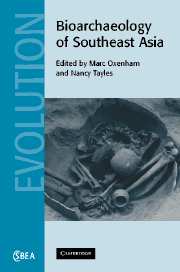Book contents
- Frontmatter
- Contents
- List of contributors
- Foreword: Emerging frontiers in the bioarchaeology of Southeast Asia
- Preface
- 1 Introduction: Southeast Asian bioarchaeology past and present
- Part I Morphological diversity, evolution and population relationships
- Part II Health, disease and quality of life
- 8 Subsistence change and dental health in the people of Non Nok Tha, northeast Thailand
- 9 Human biology from the bronze age to the iron age in the Mun River valley of northeast Thailand
- 10 Palaeodietary change among pre-state metal age societies in northeast Thailand: a study using bone stable isotopes
- 11 The oral health consequences of the adoption and intensification of agriculture in Southeast Asia
- 12 Cranial lesions on the late Pleistocene Indonesian Homo erectus Ngandong 7
- 13 ‘The predators within’: investigating the relationship between malaria and health in the prehistoric Pacific Islands
- Part III Conclusions
- Index
- References
8 - Subsistence change and dental health in the people of Non Nok Tha, northeast Thailand
Published online by Cambridge University Press: 18 November 2009
- Frontmatter
- Contents
- List of contributors
- Foreword: Emerging frontiers in the bioarchaeology of Southeast Asia
- Preface
- 1 Introduction: Southeast Asian bioarchaeology past and present
- Part I Morphological diversity, evolution and population relationships
- Part II Health, disease and quality of life
- 8 Subsistence change and dental health in the people of Non Nok Tha, northeast Thailand
- 9 Human biology from the bronze age to the iron age in the Mun River valley of northeast Thailand
- 10 Palaeodietary change among pre-state metal age societies in northeast Thailand: a study using bone stable isotopes
- 11 The oral health consequences of the adoption and intensification of agriculture in Southeast Asia
- 12 Cranial lesions on the late Pleistocene Indonesian Homo erectus Ngandong 7
- 13 ‘The predators within’: investigating the relationship between malaria and health in the prehistoric Pacific Islands
- Part III Conclusions
- Index
- References
Summary
Introduction
Dentition is an information-rich mainstay of research in skeletal biology, forensic science and bioarchaeology, contributing information on sex, age at death, growth and development, and diet, among others. The steadily accumulating global database of dental pathological conditions has enabled comparative research across space, time, technology and subsistence base (e.g. summary in Larsen (1997) and Pechenkina et al. (2000)). Lukacs (1989) proposed standardisation of recording and reporting dental pathological conditions and the use of a dental pathology profile (DPP) for comparative research.
The DPP was conceived to improve the comparison of dental assemblages and to suggest modes of subsistence in situations where archaeological evidence was lacking (Lukacs 1989, p. 273). Among the variables in the DPP are caries, enamel hypoplasia, calculus, alveolar resorption, severe attrition, antemortem tooth loss, periapical cavities (indicative of tooth infection) and variables of jaw robusticity and size. The transitions from hunting and gathering to agriculture and then to intensified agriculture resulted in shifts in the components of the DPP that can be chronicled and compared (Lukacs 1989, p. 276). For example, hunter–gatherers typically have low frequencies of caries, calculus, malocclusion and alveolar resorption, a high frequency of severe attrition, and large jaw size. Agricultural populations typically have the opposite profile, low rates of severe attrition (except in cases where food contains abrasives) and high rates of caries, calculus, resorption, dental crowding and malocclusion.
- Type
- Chapter
- Information
- Bioarchaeology of Southeast Asia , pp. 191 - 219Publisher: Cambridge University PressPrint publication year: 2006
References
- 13
- Cited by

